Graphics Reference
In-Depth Information
n
=
010
T
, we'll simply write
S
+
or
S
-
. Indeed, our diagrams will always
show a flat surface facing up, and we'll sometimes refer to the “upper” and “lower”
hemispheres. We'll consider light arriving from some direction
S
+
(i.e., trav-
v
i
∈
−
v
i
), and consider the scattered light from the surface, using
eling in direction
v
o
to denote a generic direction of scattered light. We'll use
f
s
(
v
i
,
v
o
)
to denote the
BSDF for light arriving in direction
v
i
and leaving in direction
v
o
. (In the case of
transmission, we'll denote the transmitted light direction
v
t
.)
While the formulation given here—an object that lies in the
y
0 half-
space, scattering light upward—is nice and simple, it's an approximation of
a larger truth, which we'll return to in Section 29.4, namely, that we have a
surface that's a boundary between
two
materials. For a glass marble, there's an
outward-pointing normal vector that points into the surrounding air, but for the
mass of surrounding air, the outward normal points into the glass! We tend to
think of air as “nothing” in graphics, but in a situation like a glass filled with
wine, the boundary between the glass and the wine serves to delimit both the
glass and the wine. Surface scattering is really a property of a
pair
of media
rather than a single medium.
≤
Before we describe the kinds of scattering, we caution that some terms are
used very informally. For example, “diffuse” can be used to mean “anything
except mirror reflection” or “very similar to Lambertian.”
Here is a collection of terms used for scattering, with figures showing some of
them.
Figure 27.2: A teapot with
generic reflective scattering
(image sequence by Kefei Lei).
•
Reflective
(Figure 27.2): The scattered light is all in the upper hemisphere,
that is,
S
+
.
•
Transmissive
(Figure 27.3): The scattered light is all in the lower hemi-
sphere, that is,
v
o
·
≥
0. More precisely,
f
s
(
v
o
)=
0for
v
o
∈
n
v
i
,
S
-
.
v
o
·
n
≤
0. More precisely,
f
s
(
v
i
,
v
o
)=
0for
v
o
∈
•
Mirror
(Figure 27.4; “specular” is a synonym): The scattered light is all
in a single direction, the mirror-reflection direction
v
r
=
2
(
v
i
·
n
)
n
−
v
i
.
The “function”
f
s
has an infinity:
f
s
(
. More precisely, trying
to measure the reflectance in the usual way fails, because the outgoing
radiance is independent of the solid angle subtended by the light source;
this means that our usual BSDF approach is inappropriate for handling
mirror-reflected light.
1
Practically speaking, this means that in the pro-
grams you write, you need to handle mirror reflection as a special case.
v
i
,
v
o
)=
∞
Figure 27.3: The teapot with pri-
marily transmissive scattering.
•
Impulse:
The scattered light is all in a single direction, but this direc-
tion is not necessarily the direction of mirror reflection. For example,
we may want to model a camera lens as purely transmissive, with all
1.
In truth, this is a case where the notion of “distribution” applies: What we tend
to write as integrals involving the BSDF typically have the form
f
s
Lg
,where
L
is
some representation of radiance and
g
represents other terms like change of variables
Jacobians, etc.; such integrals transform the radiance field
L
into either a number or
another function, and they do so linearly. Thus, “integrating against the BSDF” is just
a way to write a linear function from one function space to another. A few such linear
maps
cannot
be written this way, just like the “delta functions” of Chapter 18, but in the
quest for consistent notation, researchers in graphics pretend that they can and claim
the BSDF “is infinite” at certain points of its domain.
Figure 27.4: The teapot with mir-
ror scattering.












